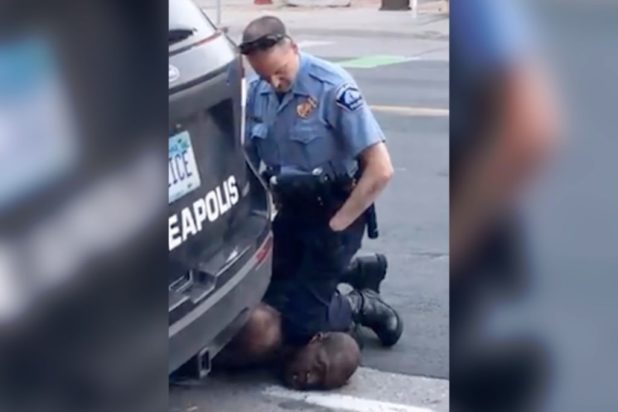The medical examiner’s initial report is out for George Floyd, and it seems that the obvious is true: he was not suffocated to death.
George Floyd died Monday from a combination of preexisting health conditions exacerbated by being held down by Minneapolis officers, not from strangulation or asphyxiation, based on the medical examiner’s initial report.
Preliminary findings from a Tuesday autopsy conducted by the Hennepin County Medical Examiner found “no physical findings that support a diagnosis of traumatic asphyxiation or strangulation,” according to the criminal complaint filed Friday against former officer Derek Michael Chauvin.
“Mr. Floyd had underlying health conditions including coronary artery disease and hypertensive heart disease,” said the complaint from the Hennepin County Attorney. “The combined effects of Mr. Floyd being restrained by police, his underlying health conditions and any potential intoxicants in his system likely contributed to his death.”
The Minneapolis police officer fired earlier this week was charged Friday with third-degree murder and manslaughter after kneeling on Mr. Floyd’s neck for 8 minutes and 46 seconds. Video showed he was unresponsive for the last 2 minutes and 53 seconds.
…
Mr. Floyd, who was six feet tall and weighed over 200 pounds, was handcuffed and led to the squad car, but resisted getting inside, saying he was claustrophobic.
16/ Read the complaint charging ex-Minneapolis officer Derek Chauvin with the murder of #GeorgeFloyd: https://t.co/ubEbbVJOfg
— The Minnesota Star Tribune (@StarTribune) May 29, 2020
15/ The criminal complaint against Chauvin, citing the autopsy, pointed out that #GeorgeFloyd did not die from strangulation but a combination of being restrained along with various underlying medical conditions including heart disease and hypertension. https://t.co/8owtCpF2AH
— The Minnesota Star Tribune (@StarTribune) May 29, 2020
While standing, he said repeatedly he couldn’t breathe. Mr. Floyd struggled as officers tried to force him into the car and fell to the ground. Two officers held him down while Officer Chauvin pressed his knee on the suspect’s neck.
Mr. Floyd said “I can’t breathe” multiple times, as well as “Mama” and “please.” After he stopped moving, an officer checked for his pulse and said, “I couldn’t find one.”
“None of the officers moved from their positions,” the complaint said. About two minutes later, Officer Chauvin removed his knee.
Mr. Floyd was transported by ambulance to the Hennepin County Medical Center, where he was pronounced dead.
…
The full medical examiner’s report is pending.
Until the full report comes out, we can’t really know what happened. A lot of right-wing internet people are taking the statement that he was not strangled or asphyxiated (which was already obvious) to mean that he was not, effectively, killed by the police.
We already know that he was hypertensive with coronary artery disease, and that he additionally may have been on illegal drugs that should not be taken by people with those conditions, and then he became stressed and agitated by being arrested. He was complaining about claustrophobia with respect to being put in a police car, which indicates that he might have had a panic attack. This is known to happen to people on drugs, particularly cannabis.
So, that’s three factors for a cardiac emergency to begin with – pre-existing, drugs, and panic. He was also 46 years old, which is itself a risk factor compared to being, say, 26.
Then, you had the police kneeling on his neck for 8 minutes and 46 seconds. It is basically impossible to tell from the video how much weight was being applied to his neck – this depends on tension, not just position.
In the worst case, the police officer here could have partially or fully compressed his right carotid artery for that much time, and that could have contributed to his ultimately having a stroke. This would be cruel and excessive police treatment of a restrained person, but not fatal to healthy people.
However, the fact that he was complaining of shortness of breath indicates that he had a heart attack, not a stroke. People having heart attacks very commonly experience shortness of breath, whereas people having strokes more often experience confusion, numbness, blindness, etc.
So, if I had to bet money on cause of death, I would say that he died of a heart attack. In this case, the police would have simply failed to recognize that he was having a heart attack and render aid, unrelated to his being kneeled on. This would have been unfortunate, but is something that is bound to happen.
Hypertensive black men in their mid-forties, on drugs, with coronary artery disease are known to die of heart attacks. They are also known to get arrested. Sooner or later, both things were bound to happen on the same day, and it was bound to get filmed because every arrest gets filmed these days.
The sensible reaction to this would be to decide that the police should be trained to recognize when people they are detaining have medical emergencies. Heart attacks are common, and they should be trained to ask people if they have heart disease if they start showing signs of having a heart attack, as George Floyd was.
The other reaction would be to just burn down everything and then have a police state. America being the country that it is, this is the most probable outcome, and also the one we are seeing unfold.
The heart attack theory assumes that this event actually happened as shown, and was not staged. We do not know that.
But, if we assume that this happened as shown, I think a heart attack is the best theory, until the full autopsy is released.


